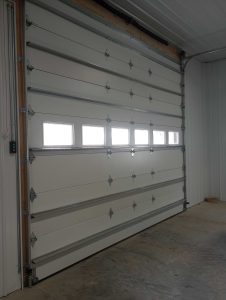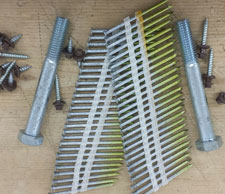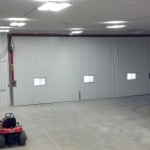Welcome to Ask the Pole Barn Guru – where you can ask questions about building topics, with answers posted on Mondays. With many questions to answer, please be patient to watch for yours to come up on a future Monday segment. If you want a quick answer, please be sure to answer with a “reply-able” email address.
Email all questions to: PoleBarnGuru@HansenPoleBuildings.com
DEAR POLE BARN GURU: I know some companies hand nail exclusively. I have 3 1/4″ ring shank galvanized nails I can shoot from a Paslode nail gun. Is that sufficient for girts and windows/door framing. I forgot the email on a previous question.
Thanks. SCOTT IN MACOMB
DEAR SCOTT: I have no issues with nail guns – my Dad and uncles were considered pioneers when they were using nail guns on framing projects fifty years ago. If it wouldn’t have resulted in an equal to or better solution, there is no way they would have done it.
Personally – hand nailing just gives me big forearms and sore elbows. Some of which could be at 57 I still use the heaviest framing hammer head I can swing (I prefer to drive nails in the fewest swings possible). When I was a teenager, I was so impressed my Uncle Gil could fully set and drive two 16d sinkers at one time with one swing! Footnote: my Dad (Uncle Gil’s older brother) was not impressed – as the two nails ended up being too close to each other.
As to your particular choice of nail, they may or may not work, and I would defer to the nails which were specified on the plans by the RDP (Registered Design Professional – Engineer or Architect) who designed your building. Both nail length and diameter are crucial in obtaining the correct results which will adequately meet structural criteria.
The most common nail choice errors I see are – nails which are too long, too small in diameter or the use of non-galvanized nails. A tried and true rule for nailing – never drive the tip of a nail into a piece of wood greater in depth than the width of the face you are nailing into.
Example, attaching one 2×4 or 2×6 to another, where the nail goes through the wide face of one board, into the narrow 1-1/2 inch face of the second. The maximum nail length in this case should be three inches.
Your building plans, or the instructions which came with them, should also include information as to minimum distances between the nail location and edge or end of the pieces being nailed, as well as minimum on center spacing. All of these are a result of testing to minimize connection failures.
Mike the Pole Barn Guru
DEAR POLE BARN GURU: On your residential buildings what do you do for the foundation as far as heating? Do you pour a footer? WILL
DEAR WILL: My personal preference is to use an elevated wood floor over a crawl space – using batt insulation between the floor joists. I happen to find this surface far more comfortable to live on top of. (read more about post frame crawl spaces here: https://www.hansenpolebuildings.com/blog/2013/03/crawl-space/)
For slab on grade, you will want to read these articles (see the second answer of the Dear Pole Barn Guru one):
https://www.hansenpolebuildings.com/blog/2012/10/concrete-slab-4/
https://www.hansenpolebuildings.com/blog/2015/04/steel-panel/
Mike the Pole Barn Guru
DEAR POLE BARN GURU: I have always planned on an outbuilding here. Initially I was going to build something over the existing well and make it big enough to house a lawn mower and other yard equipment. The well has power to it.
I had a separate electrical panel put in expecting to later build a shop. Now that I am here I am thinking it would be easier to do the shop and the well “shed” all at once so I was thinking about a building maybe 16’ wide and 40’ or longer running down (3’ off) the property line.
What do you think about having a pole barn that size put up and then coming back at my leisure and adding a stem wall, dirt, and concrete floor and then framing in portions of it as I see fit – some with walls, insulation, window AC units, some with walls and doors – maybe even rollup doors, and some just open.
Will costs to do this be higher than planning a building in the final configuration and going that route?
Thanks, JOHN IN LYNN HAVEN
DEAR JOHN: In the greatest majority of cases, it is more efficient and economical, as well as having a great resale value, to construct a single building, rather than two. The one exception which comes to mind first – is in cases where mixed use occupancies create fire separation issues.
To get the most bang for your buck, I would recommend you construct the largest building which will fit on your property and within your budget. Whatever you build, it won’t be large enough over time. Make sure to be discussing your ideas early on with the local Planning Department – as they will most likely require a setback from your property lines of more than three feet (or you may be faced with some rather expensive fire walls).
Buildings which are closer to square, rather than long and narrow will also be more economical – especially in high wind areas.
Pole buildings do not require stem walls, so you will have significant savings in concrete and foundation forming costs, as compared to other forms of construction.
Also, to help reduce costs over the long haul – try to incorporate as many (if not all) of the perimeter wall features as possible (e.g. doors and windows) initially. Also, fully enclosing the building to begin with, rather than doing a roof only (pavilion style) or a three sides building will keep from having to over design for the “as built” stages.
The great thing about a pole building – is you can save on initial costs by constructing the pole building, and then adding the concrete floor later. Of course it’s nice to get it all done at once, but if you want to stretch out the budget part, this is the way to go.
Mike the Pole Barn Guru
 DEAR POLE BARN GURU: Do you sell overhead style panel doors for pole barns? I am located in FL and need a 14’x14’ barn door (possibly up to 6 total) for my large pole barn. Do you know what wind requirements are typically used? I realize Florida has a 160Mph wind rating due to hurricanes, but I am not sure if I am required to meet this requirement since this is a 25 year old pole barn I am trying to renovate (& modernize) the look, but paying $4k per door would break the bank.
DEAR POLE BARN GURU: Do you sell overhead style panel doors for pole barns? I am located in FL and need a 14’x14’ barn door (possibly up to 6 total) for my large pole barn. Do you know what wind requirements are typically used? I realize Florida has a 160Mph wind rating due to hurricanes, but I am not sure if I am required to meet this requirement since this is a 25 year old pole barn I am trying to renovate (& modernize) the look, but paying $4k per door would break the bank. DEAR POLE BARN GURU: After scouring the internet I am still confused about using non-galvanized steel nails in the MCA pt treated posts for nailing the girts. I thank you for your time and expertise. FRED in BYRDSTOWN
DEAR POLE BARN GURU: After scouring the internet I am still confused about using non-galvanized steel nails in the MCA pt treated posts for nailing the girts. I thank you for your time and expertise. FRED in BYRDSTOWN DEAR POLE BARN GURU: Hello! We live in Prior Lake and have a pole shed that needs a ceiling metal liner Installed. I’m having trouble finding anyone to do just the liner and I can finish the rest. I know you’re a few hours away but curious if you have anyone near the cities that could help. The building is a 32×32 with a 12′ ceiling made by Sherman 5 years ago. It has three overhead garage doors.
DEAR POLE BARN GURU: Hello! We live in Prior Lake and have a pole shed that needs a ceiling metal liner Installed. I’m having trouble finding anyone to do just the liner and I can finish the rest. I know you’re a few hours away but curious if you have anyone near the cities that could help. The building is a 32×32 with a 12′ ceiling made by Sherman 5 years ago. It has three overhead garage doors.





